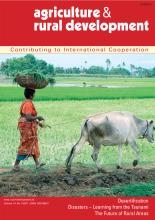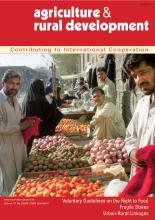Land Library
Bienvenue dans la bibliothèque du Land Portal. Explorez notre vaste collection de ressources en libre accès (plus de 74 000), comprenant des rapports, des articles scientifiques, des articles de recherche, des publications évaluées par des pairs, des documents juridiques, des vidéos et bien plus encore.
/ library resources
Showing items 1756 through 1764 of 1818.The series of dramatic natural events is never ending. 2005 again illustrated that natural disasters are unavoidable. For disaster prevention systems to function properly, investments in raising risk awareness are key.
Rural areas are not exempted from the impacts of globalisation. Global trends affecting agriculture are particularly significant in this respect. A number of options are available to developing countries in responding to these trends.
Two images have dominated the northern media in recent months.The first is of desolation in remote, rural areas in Africa affected by drought, conflict or famine, such as in Somalia, northern Kenya or Darfur, Sudan.
The rural areas of the South have undergone vital socio-economic and technological changes marked by globalisation, economic liberalization and political decentralization and by the information and communication sector.
More than 70 percent of the world's poor live in rural areas.The World Bank's approach to rural development is holistic and multisectoral, focused on improving the wellbeing of rural people by building their productive, social, and environmental assets.
Few aspects of development policy are better furnished with empirical evidence than the interplay between support for agriculture in the context of rural development and the reduction of poverty and hunger.
In November 2004, after a two-year drafting process, the FAO Council adopted the Voluntary Guidelines on the right to food - in effect, a new legal instrument for defending and enforcing the right to food.This article addresses the following questions:
Negotiations to establish a set of Voluntary Guidelines on the human right to food, held under the auspices of FAO, were successfully completed in autumn 2004, with all 174 FAO member countries signing the final document.
The Voluntary Guidelines on the human right to food provide a further instrument of international law in the fight against world hunger.The Guidelines promise to be a powerful new weapon in combating malnutrition.They forge an alliance between development policy and human rights in the struggle f


